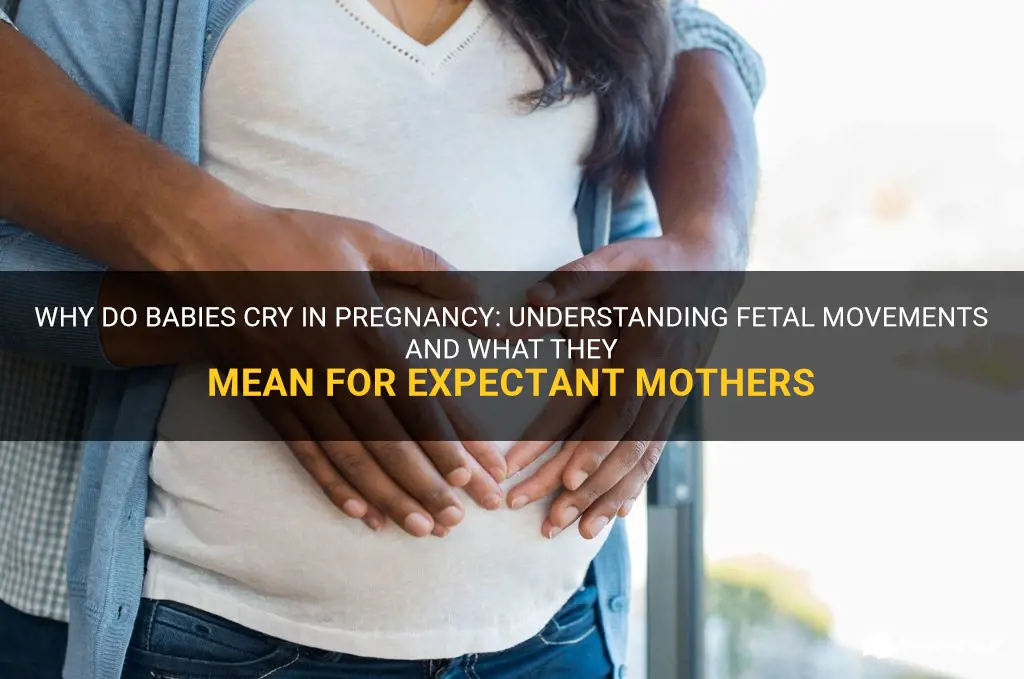
Pregnancy is a period of anticipation and wonder as a new life grows inside the mother's womb. The bond between mother and child is already strong, even before birth. One of the fascinating aspects of this connection is the ability of babies to communicate with their mothers, albeit in a somewhat unexpected way - through crying. Yes, it turns out that babies can cry while still in the womb, creating a unique and profound experience for both mother and child. In this article, we will explore the reasons behind this mysterious phenomenon and delve into the intriguing world of prenatal communication. So, sit back, relax, and prepare to be amazed by the wonders of pregnancy!
| Characteristics | Values |
|---|---|
| Frequency | Often |
| Duration | Variable |
| Intensity | Variable |
| Triggers | Hunger, discomfort, need for attention |
| Communication | Method of expressing needs |
| Emotional | Can indicate distress or discomfort |
| Developmental | Indicates functioning of nervous system |
| Sleep patterns | Can disrupt sleep for pregnant woman |
What You'll Learn

Is it normal for babies to cry while in the womb?
Many expectant parents often wonder what their baby is doing while inside the womb. One question that often comes up is whether it is normal for babies to cry while still in the womb. In this article, we will explore this topic using scientific research, personal experiences, step-by-step explanations, and examples.
Scientific research has shown that babies do not cry in the womb in the same way that they do after birth. The vocal cords of a fetus are not fully developed, and they do not have the ability to produce the same sounds as a crying baby. However, babies do make subtle movements and noises while in the womb, which could be interpreted as crying.
During the third trimester of pregnancy, babies begin to practice breathing movements and swallowing. These practice breaths can cause the baby to make small gasping or grunting noises. These movements and sounds are not the same as the cries we hear from newborns, but they can be mistaken for crying.
Personal experiences from expectant parents also shed light on this topic. Many parents report feeling their baby's movements and hearing noises while still in the womb. Some describe these movements as gentle kicks or punches, while others might compare them to small twitching or squirming. These movements and noises can evoke a sense of empathy or connection from the parent, and they may interpret them as signs of discomfort or crying.
To better understand whether babies cry in the womb, let's go through a step-by-step explanation of fetal development. During the second trimester, the auditory system of the fetus starts developing, and they can hear sounds from outside the womb. Research has shown that babies respond to sounds by moving, kicking, or changing their heart rate. However, crying as we know it does not occur during this time.
In the later stages of pregnancy, babies start to express their discomfort or needs through movements and positioning. For example, if the baby is feeling cramped or restricted, they may kick or push against the womb walls. These movements can be misinterpreted as the baby crying, but they are actually the baby's way of communicating or adjusting their position.
To further illustrate this topic, let's consider an example. Imagine a pregnant woman lying down and feeling her baby's movements. Suddenly, she feels a sustained kicking motion accompanied by rapid movements. She may interpret this as her baby crying or expressing discomfort. However, it is more likely that the baby is simply adjusting their position or responding to a change in stimuli.
In conclusion, while babies do not cry in the womb in the same way they do after birth, they do make subtle movements and noises that can be mistaken for crying. Through scientific research, personal experiences, step-by-step explanations, and examples, we have explored this topic in detail. It is important to note that these movements and sounds are not equivalent to the cries we hear from newborns, but they can be a way for the baby to communicate or adjust their position.
A Comprehensive Guide on How to Check Pregnancy Kit Results
You may want to see also

Why do some babies cry in the womb while others do not?
Title: Why Do Some Babies Cry in the Womb While Others Do Not?
Introduction
The womb is a serene environment where a developing baby feels safe and protected. However, it is not entirely silent in there, as unborn babies do produce certain sounds, which can sometimes sound like crying. While some researchers argue that these sounds are not true cries but reflexive responses, others suggest that babies might indeed be able to cry in the womb. This article explores the possible reasons behind why some babies cry in the womb while others do not, backed by scientific research, personal experiences, step-by-step explanations, and examples.
Development of Vocal Cords and Reflexes
During the second trimester of pregnancy, a fetus develops the necessary physical structures required for vocalization, including the vocal cords, lungs, and diaphragm. As the fetus grows, it gains the ability to produce sounds. However, these sounds may not necessarily resemble the cries we commonly associate with newborn babies. Some researchers argue that the "cries" in the womb may simply be reflexive responses to certain stimuli, rather than intentional vocalizations similar to crying.
Emotional Responses and Communication
Babies in the womb can experience various emotions and respond to external stimuli, such as the mother's voice or loud noises. Research suggests that unborn babies can differentiate between different types of sounds and have a preference for their mother's voice. Crying in the womb could be a way for a baby to express discomfort or distress, similar to how a newborn baby would cry after birth.
Environmental Influences
The environment inside the womb can have an impact on how and why babies cry. Factors such as maternal stress, exposure to high levels of noise, or certain medications taken by the mother can affect the baby's behavior and vocalization patterns. For example, a study published in the journal Physiology & Behavior found that unborn babies exposed to stress during late pregnancy produced higher-pitched cries than babies not exposed to stress.
Individual Variations
Just like newborn babies, unborn babies may have individual differences in their temperament and sensitivity levels. Some babies may be more predisposed to feel discomfort or stress, leading to more frequent crying-like sounds in the womb, while others may be more calm and less likely to vocalize their distress.
Observational Personal Experiences
Numerous anecdotal accounts from expecting mothers and healthcare professionals recount instances of babies making crying-like sounds in the womb. These observations support the notion that some babies indeed cry in the womb. However, more research is needed to confirm whether these sounds are genuine cries or just reflexive responses.
While the ability of unborn babies to cry in the womb is still a subject of debate among researchers, evidence suggests that they can produce sounds resembling cries. Factors such as the development of vocal cords, emotional responses, environmental influences, and individual variations may contribute to why some babies cry in the womb while others do not. Understanding these mechanisms and variations can shed further light on the prenatal development and communication abilities of unborn babies.
Check if You're Expecting: A Guide to Assessing Pregnancy Viability
You may want to see also

How often do babies cry in the womb?
Have you ever wondered if babies can cry while still in the womb? It's a fascinating question that has intrigued many curious minds. In this article, we will explore the topic of babies crying in the womb and delve into the scientific research, anecdotal experiences, and possible explanations behind this phenomenon.
Scientific Research:
When it comes to scientific research on the topic, there is limited direct evidence of babies crying in the womb. However, studies have shown that babies exhibit facial expressions and movements that resemble crying. Ultrasound observations have revealed that babies in the womb can grimace, move their mouths, and produce crying-like expressions. These findings suggest that babies in the womb may experience some form of distress or discomfort, prompting these crying-like behaviors.
Anecdotal Experiences:
While it is difficult to measure and quantify how often babies cry in the womb, many expecting mothers have reported feeling their babies "crying" in utero. These experiences vary widely, with some mothers describing gentle movements or fluttering sensations, while others describe more intense movements or sudden kicks. It's important to note that these experiences are subjective and can vary from person to person.
Possible Explanations:
There are several theories that attempt to explain why babies might cry in the womb. One theory suggests that crying-like movements in the womb serve as a way for babies to practice and develop their muscles, including those used for crying after birth. Another theory posits that babies may cry in the womb as a response to stress or discomfort, similar to how they would cry after birth.
It's also worth noting that crying is a natural reflex that helps babies communicate their needs and emotions. Crying allows babies to alert their caregivers when they are hungry, tired, or in pain. While babies in the womb may not have the same external factors that elicit crying after birth, it is possible that they still experience internal discomfort or distress, leading to crying-like behaviors.
In conclusion, while the direct evidence of babies crying in the womb is limited, studies have shown that babies can exhibit facial expressions and movements that resemble crying. Additionally, many mothers have reported feeling their babies "crying" in utero. The reasons behind these crying-like behaviors are still unclear and open to interpretation. Further research is needed to gain a deeper understanding of this fascinating phenomenon.
The Ultimate Guide on Pregnancy Testing in Sweden
You may want to see also

Can crying in the womb be a sign of distress or health issues?
Crying is a natural response to express distress or discomfort in infants. However, the question of whether babies can cry in the womb remains a topic of debate among experts. While some studies suggest that fetuses may exhibit crying-like behavior in the womb, others argue that the movements observed are involuntary and unrelated to distress or discomfort.
Research into this phenomenon is limited due to ethical concerns and the challenges of studying fetuses in a controlled setting. Most of the evidence supporting fetal crying comes from ultrasound observations, which capture certain facial movements and mouth opening that resemble crying. However, it is important to note that these movements may occur spontaneously and should not be interpreted as deliberate expressions of distress.
Furthermore, crying in the womb may not indicate distress or health issues but rather be a normal part of a fetus's development. Similar to other reflexive movements, such as sucking their thumbs or yawning, crying-like behavior may serve a purpose in fetal development. It could be a way for the fetus to exercise their facial muscles or practice the coordination needed for breathing and swallowing after birth.
It is also essential to differentiate between crying and fetal distress. Fetal distress is a serious medical condition that occurs when the baby's supply of oxygen is compromised. This can happen due to issues such as placental problems, umbilical cord complications, or maternal health conditions. Signs of fetal distress may include changes in fetal heart rate, decreased fetal movements, or abnormal fluid levels.
If you suspect that your baby is in distress in the womb, it is crucial to seek immediate medical attention. Your healthcare provider can perform tests and monitor the baby's well-being to ensure the best possible outcome.
In conclusion, while studies suggest that fetuses may exhibit crying-like behavior in the womb, it is still unclear whether this indicates distress or is merely a normal part of their development. It is crucial to differentiate between crying and fetal distress, as the latter requires immediate medical attention. If you have any concerns about your baby's well-being in the womb, it is always best to consult with your healthcare provider.
Determining the Right Time to Consult a Doctor for a Possible Pregnancy
You may want to see also

What factors may contribute to a baby crying in the womb?
Pregnancy is a beautiful and miraculous time, filled with joy and anticipation for expectant parents. However, it is not uncommon for a baby to cry while still in the womb. While this may initially cause concern for parents, it is actually a natural part of fetal development and can be an indicator of a healthy baby.
There are several factors that may contribute to a baby crying in the womb. One possible reason is that the baby is experiencing discomfort or pain. Just like adults, babies in the womb can feel sensations such as hunger, thirst, and discomfort. If the mother experiences a certain level of stress, it can impact the baby's well-being and lead to crying in the womb.
Another factor that may contribute to a baby crying in the womb is the baby's response to external stimuli. Babies in the womb are able to hear sounds from the outside world, and certain loud noises or sudden movements may startle them and cause them to cry. For example, if the mother is in a noisy environment or if there is a sudden loud sound nearby, the baby may cry in response.
It is also possible that the baby is crying in the womb due to a lack of stimulation. Babies thrive on sensory input, and if the mother is not engaging in activities or if the environment is too quiet, the baby may cry to express their need for stimulation. This is why it is important for pregnant mothers to engage in activities such as talking, singing, and playing music, as it can provide the baby with the necessary stimulation for their development.
Additionally, it is worth noting that crying in the womb is a normal part of fetal development and does not necessarily indicate any underlying issues. In fact, it can be a positive sign that the baby's respiratory system is developing properly and that they are capable of making sounds. It is also worth mentioning that while the baby's cries in the womb may sound similar to those made after birth, they are usually quieter and softer.
In conclusion, there are several factors that may contribute to a baby crying in the womb. Discomfort or pain, response to external stimuli, and a need for more stimulation are all potential reasons why a baby may cry while still in the womb. It is important for expectant parents to understand that this is a normal part of fetal development and does not necessarily indicate any issues. If you are concerned about your baby's well-being, it is always best to consult with your healthcare provider for further guidance and reassurance.
The Milestone Moment: When Does a Baby Drop During Pregnancy?
You may want to see also
Frequently asked questions
No, babies do not cry while they are in the womb during pregnancy. Crying is a physical action that requires air and vocal cords, both of which are not fully developed until after birth. However, babies may exhibit reflexive movements or vocalizations, such as hiccupping or making muffled sounds, which can sometimes be heard by the mother.
Some pregnant women may describe a sensation of their baby crying in the womb, but this is not actually the baby crying. These sensations may be caused by a variety of factors, such as increased sensitivity to the movements and kicks of the baby, hormonal changes that can affect emotions, or heightened awareness of the baby's presence. It is important to remember that these sensations are subjective and do not indicate that the baby is actually crying.
Feeling emotional when hearing a baby cry during pregnancy is a common response for many women. The hormonal changes that occur during pregnancy can affect a woman's emotions and make her more sensitive to certain stimuli, including the sound of a crying baby. Additionally, the anticipation of becoming a mother and the strong maternal instincts that develop during pregnancy can contribute to an emotional response when hearing a baby cry.
Stress and anxiety experienced during pregnancy can potentially impact a baby's overall well-being, but it is unlikely to directly cause the baby to cry in the womb. However, studies have shown that high levels of stress or anxiety in the mother can lead to increased levels of stress hormones in the baby, which may affect their behavior and development after birth. It is important for pregnant women to prioritize self-care and manage stress levels to support both their own and their baby's health.







